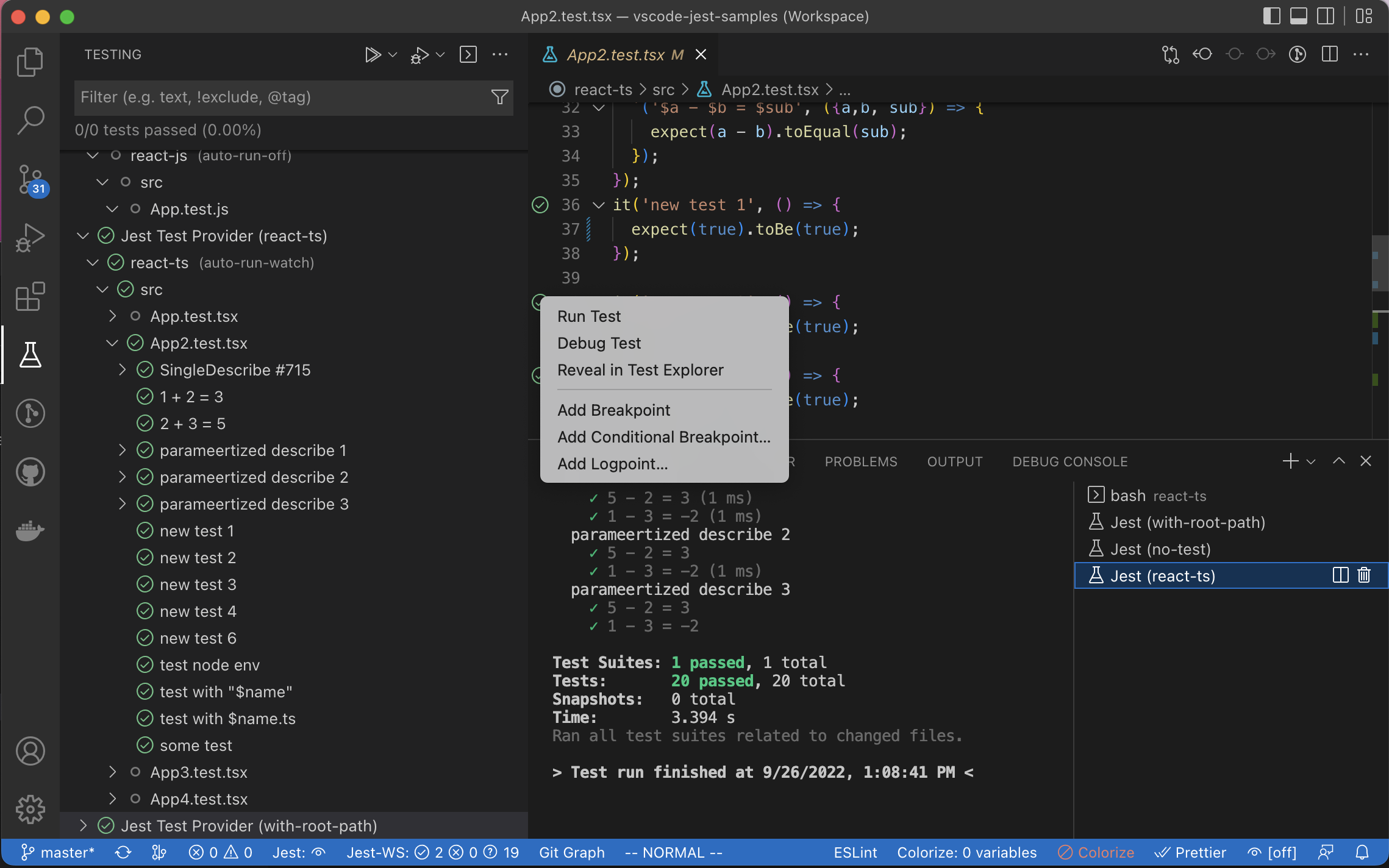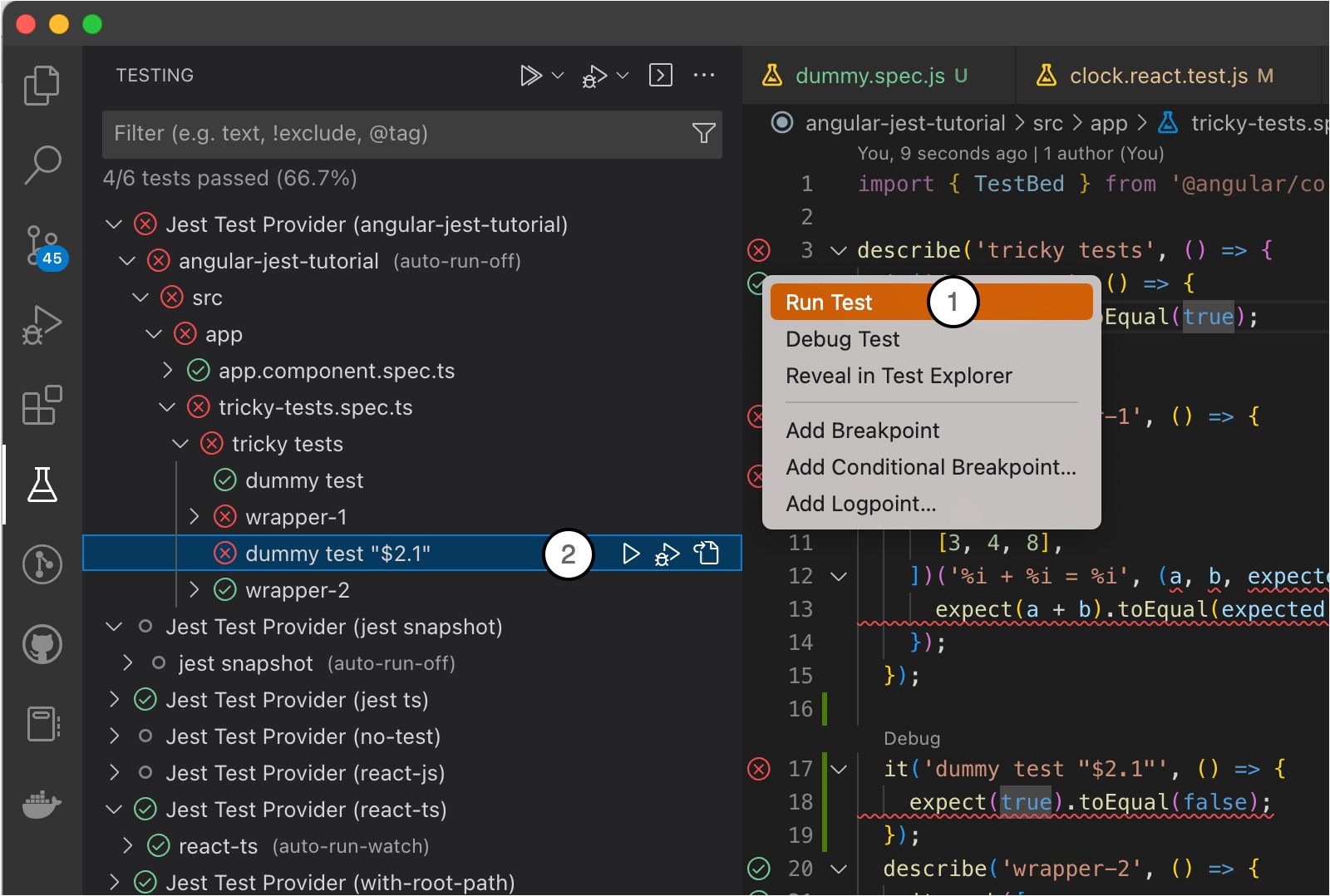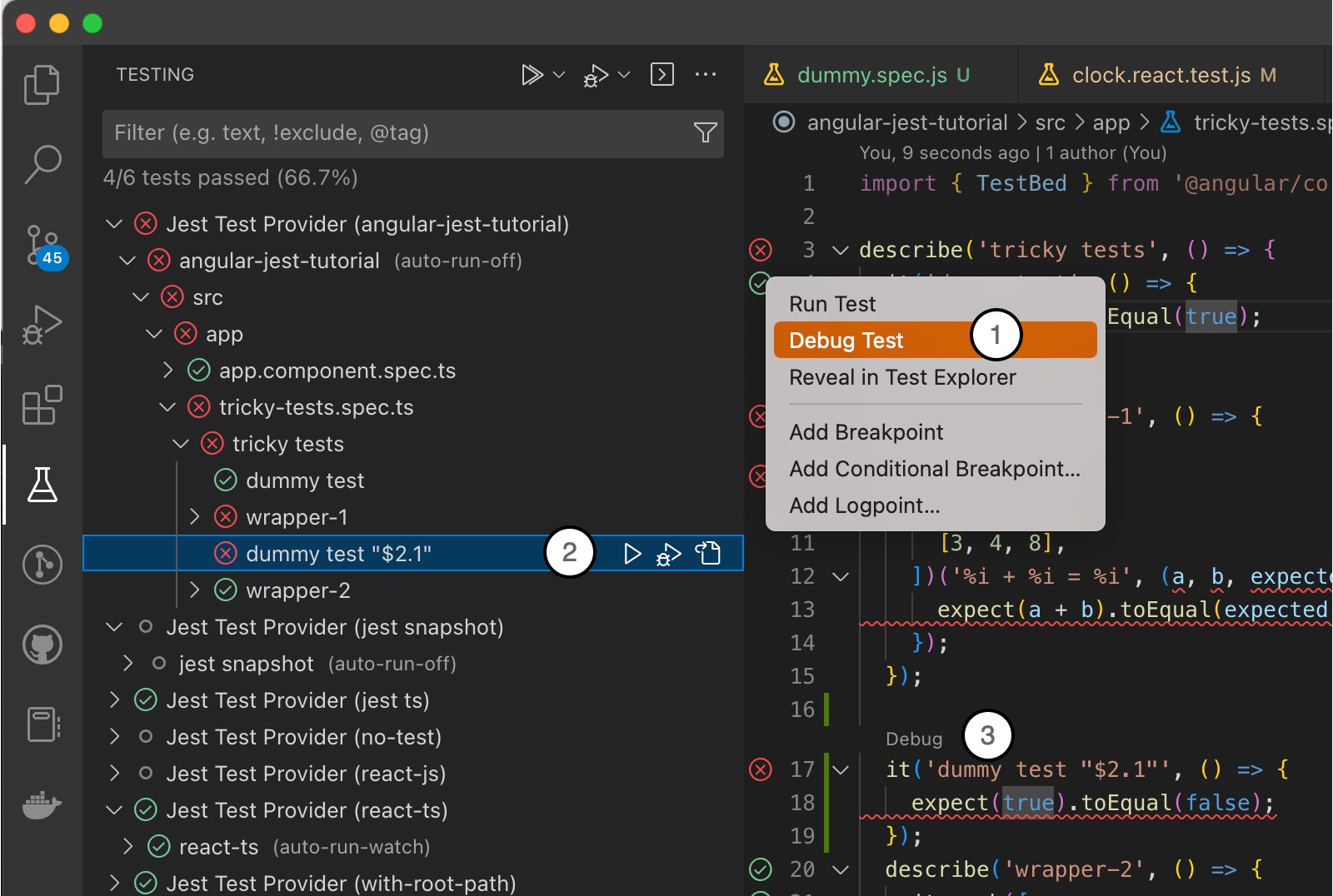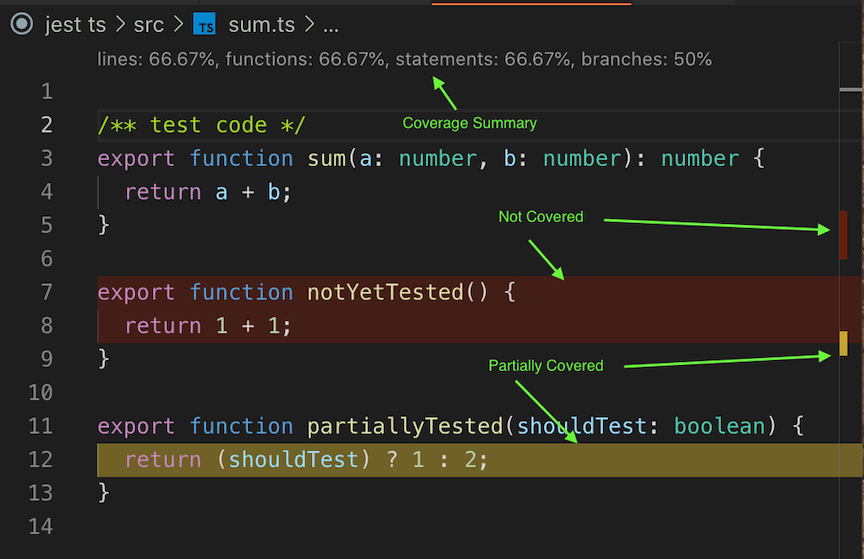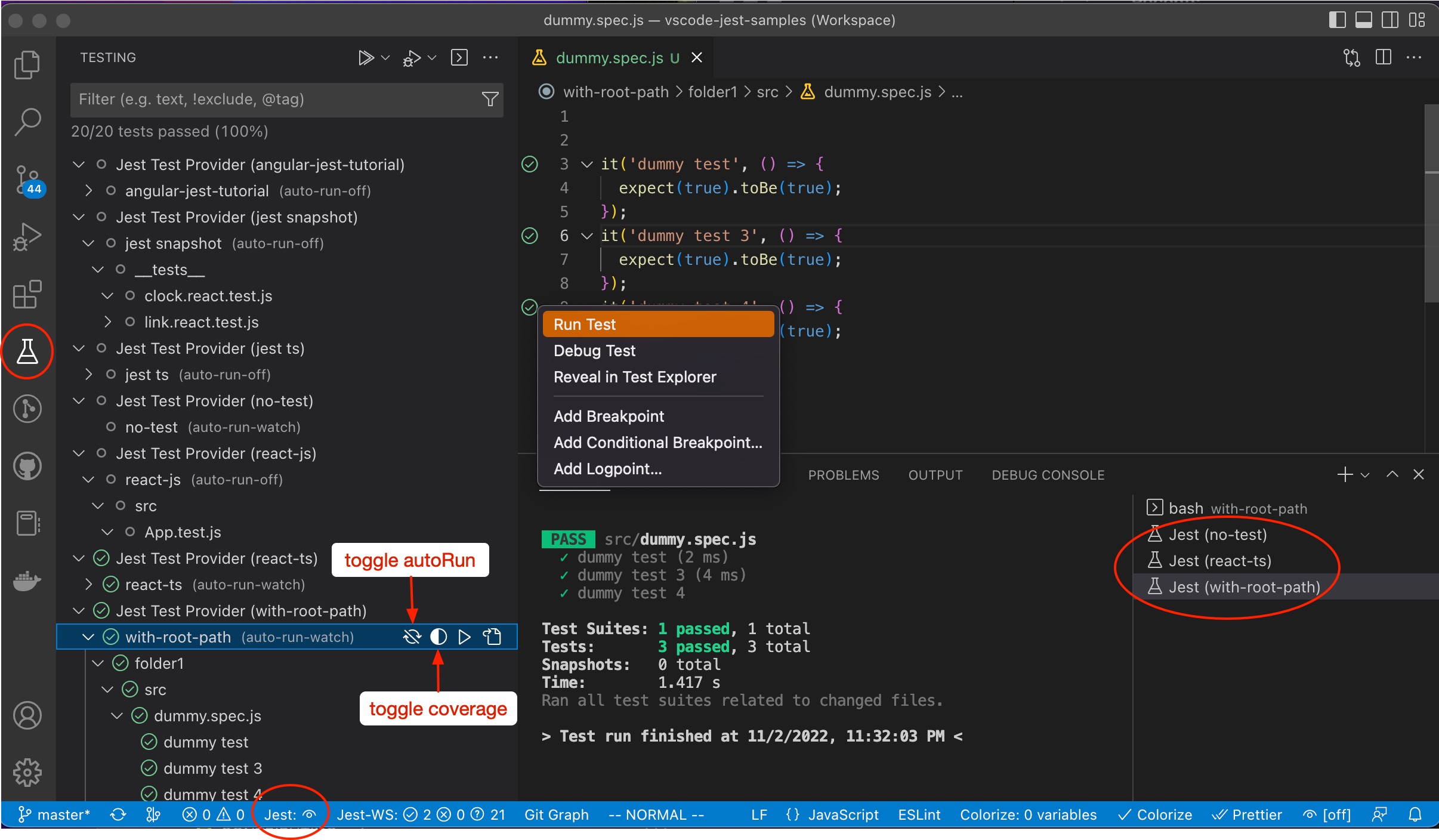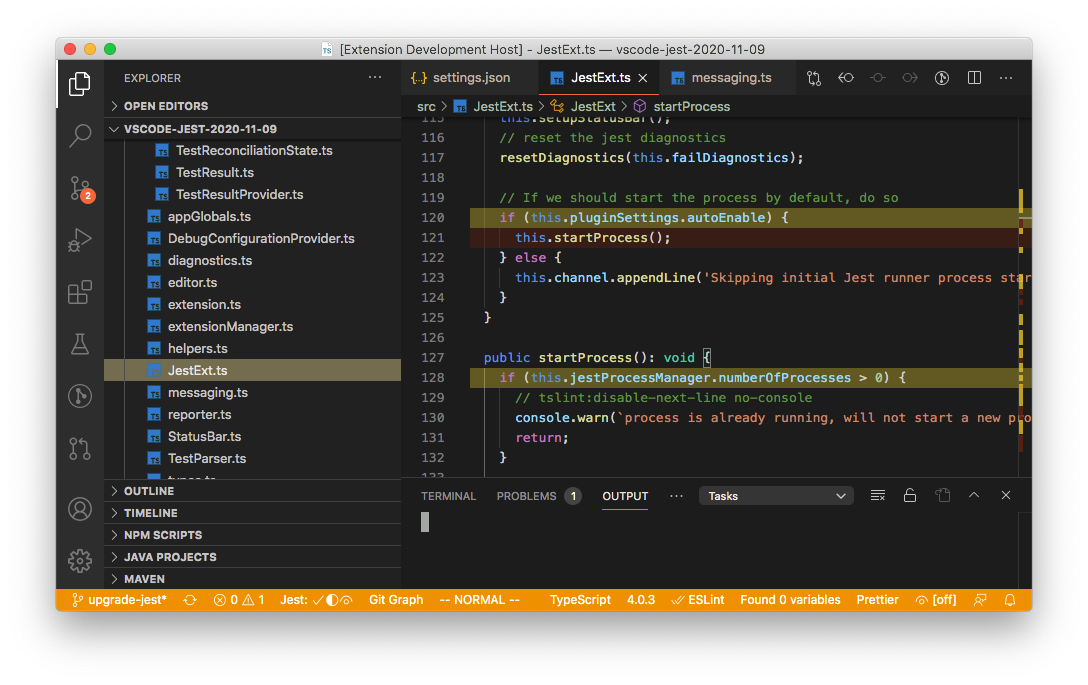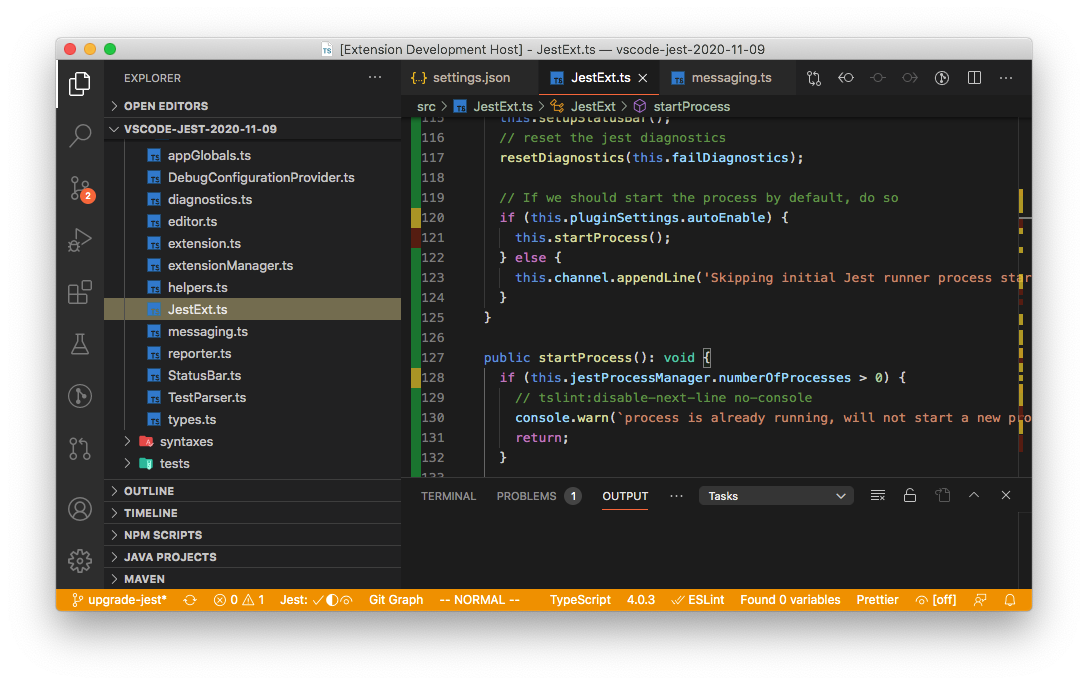This extension supports full jest features in vscode environment to make testing more intuitive and fun. It should work out-of-the-box for most common jest projects. To get started:
- Setup jest in your project if you haven't.
- install "Jest" extension in vscode.
- reload or restart vscode
If the extension can find the jest command, by default it will automatically run and monitor all tests in watch mode upon launch, and you should see tests, status, errors, coverage (if enabled) in TestExplorer and editors like this:
If you have a more sophisticated project configuration or prefer to run tests differently, fear not, the extension supports extensive customization settings. For example:
- you can use jest.jestCommandLine to tell the extension to use
yarn testinstead of the default jest command. - you can use jest.autoRun to optimize performance and control when the extension should run your tests.
- you can use the extension with monorepo projects, see monorepo project support for details.
You can see the full features and learn more details in the How-To section. If you encounter an unexpected error, feel free to checkout the Troubleshooting or file an issue.
Happy testing!
All: Release Notes
Content
- vscode-jest
- Starts Jest automatically when you're in a root folder project with Jest installed.
- Show individual fail / passes inline.
- Show fails inside the problem inspector.
- Highlights the errors next to the
expectfunctions. - Adds syntax highlighting to snapshot files.
- A one button update for failed snapshots.
- Show coverage information in files being tested.
- Help debug jest tests in vscode.
- Supports multiple test run modes (automated, manual, and hybrid onSave) to meet user's preferred development experience.
- Track and shows overall workspace/project test stats
Simply open Jest - Visual Studio Marketplace and click "Install". Alternatively open Visual Studio Code, go to the extension view and search for "Jest".
For detailed releases and migration help, please see releases.
The extension starts jest on behave of the user, therefore a valid Jest command is the minimal required info.
-
default jest command This extension can automatically start the jest process without any custom configuration if:
- it finds Jest installed in the workspace:
node_modules/.bin/jest - it finds the workspace has been bootstrapped with create-react-app:
node_modules/react-scripts/node_modules/.bin/jestornode_modules/react-native-scripts
- it finds Jest installed in the workspace:
-
custom jest command
- if no default jest command is found, the extension will fail unless a custom jest command is configured.
- user can set custom jest command with jest.jestCommandLine setting, for example
"jest.jestCommandLine": "yarn test". - or to use the Extension Setup Tool via command
"Jest: Setup Extension".
vscode-jest provided various on-demand test execution, as well as automated test runs:
- trigger test run via gutter menu in from of each test and describe block.
- trigger test run via test tree inline menu.
- trigger test run via command palette, such as
Jest: Run All Tests - trigger test run via editor context menu:
Jest: Run Related Tests - use autoRun to automatically trigger test runs when changes are detected
- use watchman to run related tests upon file save. (
watch) - use editor save event to trigger test run for the changed file. (
on-save) - or create a custom autoRun
- use watchman to run related tests upon file save. (
By default, users need not do anything. The default autoRun "watch" will run all related tests and populate the test tree. However, the convenience doesn't go without cost - it could sometimes trigger test runs unnecessarily. Please check the tuning tips if you encounter performance-related issues.
There are 3 ways to debug a specific test
- via gutter context menu from test status icon
- via test tree item inline menu
- via debug codeLens (to be deprecated ( poll 💬 ))
If you have problem debugging, see Customization - Debug Config.
Code coverage can be triggered via
- test tree item inline menu (see toggle coverage)
- Command Palette, select command like Jest: Toggle Coverage to activate or deactivate code coverage (see full list in commands.
The coverage state is reflected in test tree toggle menu, as well as StatusBar:
How to read coverage scheme and customize it
In addition to the coverage summary that is shown on the top of the file, each line will be marked by its coverage status according to the coverage formatter configured. There are 3 types of coverage you might see in your source code, distinguished by colors:
- "covered": if the code is covered. Either not marked or "green" by default, depends on the formatter.
- "not-covered": if the code is not covered. Marked as "red" by default.
- "partially-covered": Usually this mean the branch (such as if, switch statements) only partially tested. Marked as "yellow" by default.
- Please note, istanbuljs (the library jest used to generate coverage info) reports switch branch coverage with the first "case" statement instead of the "switch" statement.
You can customize coverage start up behavior, style and colors, see customization for more details.
The extension supports monorepo projects in the following configurations:
- Single-root workspace: If all tests from monorepo packages can be run from a centralized location, such as project root, then a single-root workspace with proper "jest.jestCommandLine" and "jest.rootPath" setting should work.
- Multi-root workspace: If each monorepo package has its own local jest root and configuration, a multi-root workspaces is required. Users can use
"jest.disabledWorkspaceFolders"to exclude the packages from jest run.
Users might find it easier to setup monorepo project via a Setup Tool.
Please note, a working jest environment is a prerequisite for this extension. If you are having problem running the tests from a terminal, please follow jest instruction to set it up first.
StatusBar shows 2 kinds of information:
Jest shows the mode and state of the "active" workspace folder.
Jest-WS shows the total test suite stats for the whole workspace.
Clicking on each of these button will reveal the OUTPUT channel with more details.
Illustration

 shows the active workspace has coverage on.
shows the active workspace has coverage on.

shows the active workspace has onSave for test file only, and that the workspace stats is out of sync with the code, such as when the source file is changed but the related tests are not run yet.

shows the autoRun will be triggered by either test or source file changes.
Users with vscode v1.59 and vscode-jest v4.1 and up will start to see tests appearing in the test explorer automatically. Test explorer provides a "test-centric" view, allows users to run/debug tests directly from the explorer (in addition to the inline debug codeLens), and provides a native terminal output experience (with colors!):
How to toggle autoRun for the workspace?
- In TestExplorer, click on the root of the test tree, i.e. the one with the workspace name and the current autoRun mode. You will see a list of buttons to its right.
- Click on the autoRun button (see image above) to toggle it on or off.
- If autoRun is originally on, the button will turn it off and users can use the run menu (in both editor gutter and test explorer tree) to trigger test run(s).
- If the autoRun is originally off, the button will turn it on by restoring to your original autoRun setting, if it is not "off", otherwise it will switch to "on-save" mode instead.
How to toggle test coverage for the workspace?
- In TestExplorer, click on the root of the test tree, i.e. the one with the workspace name and the current autoRun mode. You will see a list of buttons to its right.
- Click on the coverage button (see image above) to toggle on or off.
- The next test run (auto or manual) will start reporting test coverage.
You can further customize the explorer with jest.testExplorer in settings.
It is usually helpful to see the actual command and shell environment the extension spawned for your project. You can see them in the developer console (via Help > Toggle Developer Tools menu), for example to examine the PATH environment variables: look for the "spawn" log, expand the "options" object, expand "env" property, all env variables (inherited from vscode process) should be there (view animation).
You can also see process output in the following methods:
- The color coded process output terminal from TestExplorer. If it is not open or not updated, you can manually open it from TestExplore view (the square arrow icon on the top of the Explorer View)
- Otherwise you can see the output in "OUTPUT" channel, which is usually named after the workspace folder, such as
Jest (your-workspace-name). Or you can click onJestlabel on status bar to show Jest Output window. This will show you the jest run output and the errors.
You can also turn on the debug mode to see more internal debugging message in the developer console:
- set
"jest.debugMode": truein.vscode/settings.json
Users can use the following settings to tailor the extension for their environments.
- All settings are prefixed with
jestand saved in standard.vscode/settings.json. - settings crossed out are to be deprecated in the future
- settings marked with 💼 apply to the whole project, otherwise per workspace.
| setting | description | default | example/notes |
|---|---|---|---|
| Process | |||
| Automatically start Jest for this project | true | Please use autoRun instead | |
| jestCommandLine | The command line to start jest tests | undefined | "jest.jestCommandLine": "npm test -" or "jest.jestCommandLine": "yarn test" or "jest.jestCommandLine": "node_modules/.bin/jest --config custom-config.js" |
| nodeEnv | Add additional env variables to spawned jest process | null | "jest.nodeEnv": {"PORT": "9800", "BAR":"true"} |
| shell | Custom shell (path or LoginShell) for executing jest | null | "jest.shell": "/bin/bash" or "jest.shell": "powershell" or "jest.shell": {"path": "/bin/bash"; args: ["--login"]} |
| autoRun | Controls when and what tests should be run | undefined | "jest.autoRun": "off" or "jest.autoRun": "watch" or "jest.autoRun": {"watch": false, "onSave":"test-only"} |
| rootPath | The path to your frontend src folder | "" | "jest.rootPath":"packages/app" or "jest.rootPath":"/apps/my-app" |
| monitorLongRun | monitor long running tests based on given threshold in ms | 60000 | "jest.monitorLongRun": 120000 |
| pathToJest ❌ | The path to the Jest binary, or an npm/yarn command to run tests | undefined | Please use jestCommandLine instead |
| pathToConfig ❌ | The path to your Jest configuration file" | "" | Please use jestCommandLine instead |
| runAllTestsFirst ❌ | Run all tests before starting Jest in watch mode | undefined | Please use autoRun instead |
| Editor | |||
| Whether errors should be reported inline on a file | -- | This is now deprecated in favor of jest.testExplorer |
|
| testExplorer | Configure jest test explorer | null | {"showInlineError": "true"} |
| Snapshot | |||
| enableSnapshotUpdateMessages | Whether snapshot update messages should show | true | "jest.enableSnapshotUpdateMessages": false |
| enableSnapshotPreviews 💼 | Whether snapshot previews should show | true | "jest.enableSnapshotPreviews": false |
| restartJestOnSnapshotUpdate ❌ | Restart Jest runner after updating the snapshots | false | This is no longer needed in v4 |
| Coverage | |||
| showCoverageOnLoad | Show code coverage when extension starts | false | "jest.showCoverageOnLoad": true |
| coverageFormatter | Determine the coverage overlay style | "DefaultFormatter" | "jest.coverageFormatter": "GutterFormatter" |
| coverageColors | Coverage indicator color override | undefined | "jest.coverageColors": { "uncovered": "rgba(255,99,71, 0.2)", "partially-covered": "rgba(255,215,0, 0.2)"} |
| Debug | |||
| enableCodeLens 💼 | Whether codelens for debugging should show | true | "jest.enableCodeLens": false |
| debugCodeLens.showWhenTestStateIn 💼 | Show the debug CodeLens for the tests with the specified status. (window) | ["fail", "unknown"] | "jest.debugCodeLens.showWhenTestStateIn":["fail", "pass", "unknown"] |
| Misc | |||
| debugMode | Enable debug mode to diagnose plugin issues. (see developer console) | false | "jest.debugMode": true |
| disabledWorkspaceFolders 💼 | Disabled workspace folders names in multiroot environment | [] | "jest.disabledWorkspaceFolders": ["package-a", "package-b"] |
| showTerminalOnLaunch 💼 | automatically open test explorer terminal on launch (>= v4.5) | true | "jest.showTerminalOnLaunch": false |
This should be the command users used to kick off the jest tests in the terminal. However, since the extension will append additional options at run time, please make sure the command line can pass along these options, which usually just means if you uses npm, add an additional "--" at the end (e.g. "npm run test --") if you haven't already in your script.
It is recommended not to add the following options as they are managed by the extension: --watch, --watchAll, --coverage
If your project doesn't live in the root of your repository, you may want to customize the jest.rootPath setting to enlighten the extension as to where to look. For instance: "jest.rootPath": "src/client-app" will direct the extension to use the src/client-app folder as the root for Jest.
Possible status are: [ "fail", "pass", "skip", "unknown"]. Please note that this is a window level setting, i.e. its value will apply for all workspaces.
There are 2 formatters to choose from:
DefaultFormatter: high light uncovered and partially-covered code inlilne as well as on the right overview ruler. (this is the default)
(Note, there is an known issue in vscode (microsoft/vscode#5923) that gutter decorators could interfere with debug breakpoints visibility. Therefore, you probably want to disable coverage before debugging or switch to DefaultFormatter)
Besides the formatter, user can also customize the color via jest.coverageColors to change color for 3 coverage categories: "uncovered", "covered", or "partially-covered",
example
for example:
"jest.coverageColors": {
"uncovered": "rgba(255,99,71, 0.2)",
"partially-covered": "rgba(255,215,0, 0.2)",
}the default color scheme below, note the opacity might differ per formatter:
"jest.coverageColors": {
"covered": "rgba(9, 156, 65, 0.4)",
"uncovered": "rgba(121, 31, 10, 0.4)",
"partially-covered": "rgba(235, 198, 52, 0.4)",
}Performance and automation/completeness are often a trade-off. autoRun is the tool to fine-tune the balance, which is unique for every project and user.
Performance and automation are self-explanatory, "completeness" might not:
- test coverage might not be complete as it only includes the tests that ran.
- when changing the source or test code, you might not see all the tests broken until you run them explicitly.
- tests with dynamic names (test.each with variables, template-literals, etc.) will not be translated; therefore, they can only be run through parent blocks (describe-with-static-name or test suite, etc.).
There are 2 ways to change autoRun:
- Temporarily toggle autRun on/off in TestExplorer
- Change "jest.autoRun" in
settings.jsonfile.
AutoRun =
| "watch" | "off" | "legacy" | "on-save"
| { watch: true, onStartup?: ["all-tests"] }
| {
watch: false,
onStartup?: ["all-tests"],
onSave?: "test-file" | "test-src-file",
}The string type are short-hand for the most common configurations:
| Short Hand | description | actual config | note |
|---|---|---|---|
| "watch" | run jest in watch mode | {"watch": true} | the default mode |
| "off" | turn off jest autoRun | {"watch": false} | this is the manual mode |
| "legacy" | starting a full test-run followed by jest watch | {"watch": true, "onStartup": ["all-tests"]} | he default mode prior to v4.7 |
| "on-save" | run jest upon source or test file changes | {"watch": false, "onSave": "test-src-file"} |
User can also pass the actual config in the .vscode/settings.json, see more example below.
example
-
Turn off auto run, users need to trigger tests run manually via run commands and menus:
"jest.autoRun": "off"
-
Run all the tests in the workspace upon extension startup, followed by jest watch run for subsequent test/src file changes.
"jest.autoRun": "legacy"
or
"jest.autoRun": { "watch": true, "onStartup": ["all-tests"] }
-
Only run tests in the test file when the test file itself changes. It will neither run all tests for the workspace upon startup nor trigger any test run when the source file changes.
"jest.autoRun": { "watch": false, "onSave": "test-file" }
-
Like the one above but does run all tests upon extension start up
"jest.autoRun": { "watch": false, "onSave": "test-file", "onStartup": ["all-tests"] }
Note: migration rule for default autoRun:
- if
"jest.autoEnabled" = false=> manual mode:"jest.autoRun": "off" - if
"jest.runAllTestsFirst" = true=>"jest.autoRun": {"watch": true, "onStartup": ["all-tests"] } - if no customization of the 2 settings and no
"jest.autoRun"found =>"jest.autoRun": "watch"
testExplorer = {showInlineError?: boolean}showInlineError: (optional) show vscode style inline error and error message viewer. Default is false.
shell = string | LoginShell;
interface LoginShell
{
path: string;
args: string[];
}By default, jest command is executed in default shell ('cmd' for windows, '/bin/sh' for non-windows). Users can use the "jest.shell" setting to either pass the path of another shell (e.g. "/bin/zsh") or a LoginShell config, basically a shell path and login arguments (e.g. {"path": "/bin/bash", "args": ["--login"]})
Note the LoginShell is only applicable for non-windows platform and could cause a bit more overhead.
This extension looks for jest specific debug config ("vscode-jest-tests" or "vscode-jest-tests.v2") in the following order:
- workspace folder
.vscode/launch.json. - workspace
xxx.code-workspace, if exists - generated default config
The default config should work for most standard jest or projects bootstrapped by create-react-app, however it might fall short for more sophisticated projects. Please use the setup tool to help you configure or edit the launch.json file manually.
If you choose to edit the launch.json manually, you can use the jest templates, such as "Jest: Default jest configuration" or "Jest: create-react-app", as a starting point. See more detail on how to add debug config in vscode Debugging.
There are many information online about how to setup vscode debug config for specific environments/frameworks, you might find the following helpful:
- vscode debug config properties
- Launch configurations for common scenarios
- vscode-recipes for debug jest tests
v4.3 introduces a "variable substitution" based config with name "vscode-jest-tests.v2". The extension will merely substitute the jest variables in the config, without adding/removing anything else.
Currently supported variables:
- ${jest.testNamePattern} - will be replaced by the test block's full name (include the surrounding describe block names).
- ${jest.testFile} - will be replaced by the test file name.
- ${jest.testFilePattern} - will be replaced by the test file name suitable for regex arguments such as
--testPathPattern.
Examples
- Plain jest debug config:
{ "type": "node", "name": "vscode-jest-tests.v2", "request": "launch", "program": "${workspaceFolder}/node_modules/.bin/jest", "args": [ "--runInBand", "--watchAll=false", "--testNamePattern", "${jest.testNamePattern}", "--runTestsByPath", "${jest.testFile}" ], "cwd": "${workspaceFolder}", "console": "integratedTerminal", "internalConsoleOptions": "neverOpen", "disableOptimisticBPs": true, "windows": { "program": "${workspaceFolder}/node_modules/jest/bin/jest" } } - Angular users using yarn:
{ "type": "node", "name": "vscode-jest-tests.v2", "request": "launch", "runtimeExecutable": "yarn", "args": [ "test", "--run-in-band", "--watch-all=false", "--test-name-pattern", "${jest.testNamePattern}", "--test-path-pattern", "${jest.testFilePattern}" ], "cwd": "${workspaceFolder}", "console": "integratedTerminal", "internalConsoleOptions": "neverOpen", "disableOptimisticBPs": true }
- specify a number (milliseconds) means any run exceeds this threshold will trigger a warning. The number has to be > 0.
- specify "off" to disable long-run process monitoring
Default is "jest.monitorLongRun":60000 (1 minute)
This extension contributes the following commands and can be accessed via Command Palette:
| command | description | availability |
|---|---|---|
| Jest: Start All Runners | start or restart all jest runners | always |
| Jest: Stop All Runners | stop all jest runners | always |
| Jest: Toggle Coverage | toggle coverage mode for all runners | always |
| Jest: Start Runner (Select Workspace) | start or restart the jest runner for the selected workspace | multi-root workspace |
| Jest: Stop Runner (Select Workspace) | stop jest runner for the selected workspace | multi-root workspace |
| Jest: Toggle Coverage (Select Workspace) | toggle coverage mode for the selected workspace | multi-root workspace |
| Jest: Run All Tests | run all tests for all the workspaces | always |
| Jest: Run All Tests (Select Workspace) | run all tests for the selected workspace | multi-root workspace |
| Jest: Run All Tests in Current Workspace | run all tests for the current workspace based on the active editor | always |
| Jest: Toggle Coverage for Current Workspace | toggle coverage mode for the current workspace based on the active editor | always |
| Jest: Setup Extension | start the setup tool | always |
In addition, TestExplorer also exposed many handy commands, see the full list by searching for testing in vscode keyboard shortcuts editor. One can assign/change keyboard shortcut to any of these commands, see vscode Key Bindings for more details.
User can trigger the following action from the text editor context-menu
| menu | description | keyboard shortcut |
|---|---|---|
| Jest: Run Related Tests | if in test file, run all tests in the file; if in source file, run all tests with dependency to the file | Ctrl-Option-t (Mac) or Ctrl-Alt-t |
Please see vscode Key Bindings if you want to change the keyboard shortcut.
Sorry you are having trouble with the extension. If your issue did not get resolved after checking out the how-to section and the tips below, feel free to ask the community, chances are some one else had a similar experience and could help resolving it.
If you can't run jest in the terminal, please reference jest configuration to setup accordingly.
If you can run jest manually in the terminal but the extension showed error like "xxx ended unexpectedly", following are the most common causes (see self-diagnosis if you need more debug info):
- runtime environment issue: such as the shell env is not fully initialized upon vscode start up. A good indicator is messages prefixed with "env:", or node/yarn/npm command not found, such as
env: node: No such file or directory- This should only happened in Linux or MacOS and is caused by vscode not able to fully initialize the shell env when it starts up (more details here).
- The extension usually spawns the jest process with a non-login/not-interactive shell, which inherits the vscode env. If vscode env is not complete, the jest process could fail for example the
PATHenv variable is not correct. (more details here) - There are many ways to workaround such issues:
- simply restart vscode sometimes can fix it
- start vscode from a terminal
- add
PATHdirectly tojest.nodeEnvsettings, if that is the only problem. - force the jest command to be executed in a login shell by setting "jest.shell" to a LoginShell. Note this might have some slight performance overhead.
- jest command line issue: such as you usually run
yarn testbut the extension uses the defaultjestinstead.- Try configuring the jest.jestCommandLine to mimic how you run jest from the terminal, such as
yarn testornpm run test --. The extension can auto-config common configurations like create react apps but not custom scripts like CRACO. - or you can use the "Run Setup Tool" button in the error panel to resolve the configuration issue, see Setup Tool.
- Try configuring the jest.jestCommandLine to mimic how you run jest from the terminal, such as
- monorepo project issue: you have a monorepo project but might not have been set up properly.
- see more in monorepo projects on how to set it up.
There could be other causes, such as jest test root path is different from the project's, which can be fixed by setting jest.rootPath. Feel free to check out the customization section to manually adjust the extension if needed.
The extension should be a thin wrapper on top of the jest process, i.e., it shouldn't use much more resources than the jest process itself.
Having said that, the sluggish performance for some projects/users is real, and we can help. The short answer is try turning off autoRun in the explorer, which should usually show noticeable improvement.
The long answer is a bit more complicated:
- The jest/node/watchman might be slow due to code changes, your test setup, environment, etc. See facebook/jest#11956 for a glimpse of such examples. However, this issue should impact with or without this extension. There are many resources and tips online about optimizing jest performance; we will leave it at that.
- Depending on the degree of cross-dependency or your development habit (e.g., save frequently even before the code is complete), the autoRun system ( jest watchman "watch" or "on-save") might decide to run many more tests than you intended to. Imagine adding a single test could trigger 90% of all the tests in the project... yeah we have been there, and it's not fun. If that's you, try toggling off autoRun in TestExplorer and only trigger test-run when ready with the run button in the gutter or test tree.
- But keep in mind while performance is important, turning autoRun off or setting it to be less "complete" does come with a cost, such as incomplete coverage and missing-broken-tests-detection. Please read up on the autoRun trade-off and experiment to find the one that works for you.
- Never say never; it is possible that we did something stupid. 😰 Feel free to log an issue if your performance awe still needs to be resolved after you patiently read and tried the above.
fine tune performance with autoRun demo
auto-run-perf-2.-.HD.1080p.mov
Every project and developer are different. Experiment and pick the autoRun setting that fits your style and preference!
This means the extension is not activated.
vscode will automatically activate the extension upon detecting any of the following patterns:
- jest config file (
jest.json,jest.config.js,jest.config.ts,jest.config.mjs,jest.config.cjs,jest.config.json) any where under the project root. - jest command (
node_modules/.bin/jest,node_modules/react-scripts/node_modules/.bin/jest) or react-native script (node_modules/react-native-scripts) under the project root.
If none of the auto activation criteria is met, you can do the following to manually activate the extension:
- create an empty
.vscode-jestfile at your actual project root. - start jest run via command palette:
"Jest: Start All Runners"will also activate the extension for the current vscode process.
The extension monitor excessive test run with "jest.monitorLongRun" setting. By default if any runs exceed 60 seconds, a warning message will be shown.
-
If running the tests with the extension seems to be longer than running it from a terminal, chances are you can use "jest.autoRun" to optimize it, for example:
- for process type "all-tests", you can turn off the all-tests from autoRun.
- for process type "watch-tests" or "watch-all-tests", you can maybe turn off watch mode and use "onSave" instead.
-
If the tests are slow even from the terminal, i.e. without the extension, you will need to optimize your tests, feel free to check out jest troubleshooting or other online articles.
-
If the run appeared to hang, i.e. the TestExplorer or statusBar showed test running when it is not. It might be related to this jest issue, which should be fixed after release
29.0.2. If you believe your issue is different, please file a new issue so we can take a look.
You can also turn off the monitor or change the threshold with "jest.monitorLongRun" to meet your needs.
If your test file happen to have parameterized tests, i.e. test.each variations, please make sure you have jest version >= 26.5.
If the above did not resolve your issue, please see the self-diagnosis to show more insight of why the test and result could not be matched.
vscode debug scheme is through the debug config in launch.json, which is different from the regular jest test runs that we control the jest process command (via jest.jestCommandLine). Therefore, we are experimenting with a setup tool to bridge the gap: take the user's jest.jestCommandLine and generate a launch.json entry accordingly. But given the wide variety of user environments, it might not cover all cases, thus always encourage users to experiment and fix what is not working, and feel free to let us know so we can improve the wizard for future usage.
Thanks for considering! Check here for useful tips and guidelines.
vscode-jest is MIT licensed.

